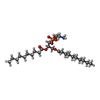+ Open data
Open data
- Basic information
Basic information
| Entry | Database: PDB / ID: 8ekq | |||||||||||||||||||||||||||||||||||||||||||||
|---|---|---|---|---|---|---|---|---|---|---|---|---|---|---|---|---|---|---|---|---|---|---|---|---|---|---|---|---|---|---|---|---|---|---|---|---|---|---|---|---|---|---|---|---|---|---|
| Title | Apo rat TRPV2 in nanodiscs, state 2 | |||||||||||||||||||||||||||||||||||||||||||||
 Components Components | Transient receptor potential cation channel subfamily V member 2 | |||||||||||||||||||||||||||||||||||||||||||||
 Keywords Keywords | TRANSPORT PROTEIN / Ion channel / TRP channel / Membrane protein / tetramer | |||||||||||||||||||||||||||||||||||||||||||||
| Function / homology |  Function and homology information Function and homology informationgrowth cone membrane / TRP channels / response to temperature stimulus / positive regulation of calcium ion import / calcium ion import across plasma membrane / axonal growth cone / positive regulation of axon extension / monoatomic cation channel activity / endomembrane system / calcium channel activity ...growth cone membrane / TRP channels / response to temperature stimulus / positive regulation of calcium ion import / calcium ion import across plasma membrane / axonal growth cone / positive regulation of axon extension / monoatomic cation channel activity / endomembrane system / calcium channel activity / melanosome / lamellipodium / positive regulation of cold-induced thermogenesis / cell body / negative regulation of cell population proliferation / axon / cell surface / identical protein binding / plasma membrane Similarity search - Function | |||||||||||||||||||||||||||||||||||||||||||||
| Biological species |  | |||||||||||||||||||||||||||||||||||||||||||||
| Method | ELECTRON MICROSCOPY / single particle reconstruction / cryo EM / Resolution: 2.6 Å | |||||||||||||||||||||||||||||||||||||||||||||
 Authors Authors | Pumroy, R.A. / Moiseenkova-Bell, V.Y. | |||||||||||||||||||||||||||||||||||||||||||||
| Funding support |  United States, 2items United States, 2items
| |||||||||||||||||||||||||||||||||||||||||||||
 Citation Citation |  Journal: EMBO J / Year: 2024 Journal: EMBO J / Year: 2024Title: Functional and structural insights into activation of TRPV2 by weak acids. Authors: Ferdinand M Haug / Ruth A Pumroy / Akshay Sridhar / Sebastian Pantke / Florian Dimek / Tabea C Fricke / Axel Hage / Christine Herzog / Frank G Echtermeyer / Jeanne de la Roche / Adrian Koh / ...Authors: Ferdinand M Haug / Ruth A Pumroy / Akshay Sridhar / Sebastian Pantke / Florian Dimek / Tabea C Fricke / Axel Hage / Christine Herzog / Frank G Echtermeyer / Jeanne de la Roche / Adrian Koh / Abhay Kotecha / Rebecca J Howard / Erik Lindahl / Vera Moiseenkova-Bell / Andreas Leffler /     Abstract: Transient receptor potential (TRP) ion channels are involved in the surveillance or regulation of the acid-base balance. Here, we demonstrate that weak carbonic acids, including acetic acid, lactic ...Transient receptor potential (TRP) ion channels are involved in the surveillance or regulation of the acid-base balance. Here, we demonstrate that weak carbonic acids, including acetic acid, lactic acid, and CO activate and sensitize TRPV2 through a mechanism requiring permeation through the cell membrane. TRPV2 channels in cell-free inside-out patches maintain weak acid-sensitivity, but protons applied on either side of the membrane do not induce channel activation or sensitization. The involvement of proton modulation sites for weak acid-sensitivity was supported by the identification of titratable extracellular (Glu495, Glu561) and intracellular (His521) residues on a cryo-EM structure of rat TRPV2 (rTRPV2) treated with acetic acid. Molecular dynamics simulations as well as patch clamp experiments on mutant rTRPV2 constructs confirmed that these residues are critical for weak acid-sensitivity. We also demonstrate that the pore residue Glu609 dictates an inhibition of weak acid-induced currents by extracellular calcium. Finally, TRPV2-expression in HEK293 cells is associated with an increased weak acid-induced cytotoxicity. Together, our data provide new insights into weak acids as endogenous modulators of TRPV2. | |||||||||||||||||||||||||||||||||||||||||||||
| History |
|
- Structure visualization
Structure visualization
| Structure viewer | Molecule:  Molmil Molmil Jmol/JSmol Jmol/JSmol |
|---|
- Downloads & links
Downloads & links
- Download
Download
| PDBx/mmCIF format |  8ekq.cif.gz 8ekq.cif.gz | 483.2 KB | Display |  PDBx/mmCIF format PDBx/mmCIF format |
|---|---|---|---|---|
| PDB format |  pdb8ekq.ent.gz pdb8ekq.ent.gz | 396.5 KB | Display |  PDB format PDB format |
| PDBx/mmJSON format |  8ekq.json.gz 8ekq.json.gz | Tree view |  PDBx/mmJSON format PDBx/mmJSON format | |
| Others |  Other downloads Other downloads |
-Validation report
| Summary document |  8ekq_validation.pdf.gz 8ekq_validation.pdf.gz | 1.5 MB | Display |  wwPDB validaton report wwPDB validaton report |
|---|---|---|---|---|
| Full document |  8ekq_full_validation.pdf.gz 8ekq_full_validation.pdf.gz | 1.5 MB | Display | |
| Data in XML |  8ekq_validation.xml.gz 8ekq_validation.xml.gz | 74.8 KB | Display | |
| Data in CIF |  8ekq_validation.cif.gz 8ekq_validation.cif.gz | 109 KB | Display | |
| Arichive directory |  https://data.pdbj.org/pub/pdb/validation_reports/ek/8ekq https://data.pdbj.org/pub/pdb/validation_reports/ek/8ekq ftp://data.pdbj.org/pub/pdb/validation_reports/ek/8ekq ftp://data.pdbj.org/pub/pdb/validation_reports/ek/8ekq | HTTPS FTP |
-Related structure data
| Related structure data |  28210MC 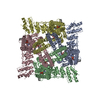 8ekpC 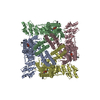 8ekrC 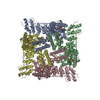 8eksC M: map data used to model this data C: citing same article ( |
|---|---|
| Similar structure data | Similarity search - Function & homology  F&H Search F&H Search |
- Links
Links
- Assembly
Assembly
| Deposited unit | 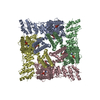
|
|---|---|
| 1 |
|
- Components
Components
| #1: Protein | Mass: 86798.891 Da / Num. of mol.: 4 Source method: isolated from a genetically manipulated source Source: (gene. exp.)   #2: Chemical | ChemComp-PEX / Has ligand of interest | N | Has protein modification | N | |
|---|
-Experimental details
-Experiment
| Experiment | Method: ELECTRON MICROSCOPY |
|---|---|
| EM experiment | Aggregation state: PARTICLE / 3D reconstruction method: single particle reconstruction |
- Sample preparation
Sample preparation
| Component | Name: Tetramer of apo wild type rat TRPV2 / Type: COMPLEX / Entity ID: #1 / Source: RECOMBINANT |
|---|---|
| Molecular weight | Value: 0.3504 MDa / Experimental value: NO |
| Source (natural) | Organism:  |
| Source (recombinant) | Organism:  |
| Buffer solution | pH: 8 |
| Specimen | Embedding applied: NO / Shadowing applied: NO / Staining applied: NO / Vitrification applied: YES |
| Vitrification | Cryogen name: ETHANE |
- Electron microscopy imaging
Electron microscopy imaging
| Experimental equipment |  Model: Titan Krios / Image courtesy: FEI Company |
|---|---|
| Microscopy | Model: FEI TITAN KRIOS |
| Electron gun | Electron source:  FIELD EMISSION GUN / Accelerating voltage: 300 kV / Illumination mode: FLOOD BEAM FIELD EMISSION GUN / Accelerating voltage: 300 kV / Illumination mode: FLOOD BEAM |
| Electron lens | Mode: BRIGHT FIELD / Nominal defocus max: 14000 nm / Nominal defocus min: 6000 nm |
| Image recording | Average exposure time: 3.54 sec. / Electron dose: 50 e/Å2 / Film or detector model: FEI FALCON IV (4k x 4k) |
- Processing
Processing
| Software | Name: PHENIX / Version: 1.20.1_4487: / Classification: refinement | ||||||||||||||||||||||||
|---|---|---|---|---|---|---|---|---|---|---|---|---|---|---|---|---|---|---|---|---|---|---|---|---|---|
| EM software | Name: PHENIX / Category: model refinement | ||||||||||||||||||||||||
| CTF correction | Type: PHASE FLIPPING AND AMPLITUDE CORRECTION | ||||||||||||||||||||||||
| Symmetry | Point symmetry: C4 (4 fold cyclic) | ||||||||||||||||||||||||
| 3D reconstruction | Resolution: 2.6 Å / Resolution method: FSC 0.143 CUT-OFF / Num. of particles: 17515 / Symmetry type: POINT | ||||||||||||||||||||||||
| Refine LS restraints |
|
 Movie
Movie Controller
Controller






 PDBj
PDBj
